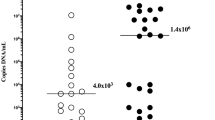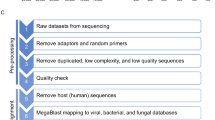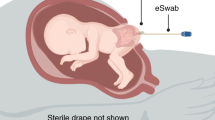Abstract
OBJECTIVE: To compare the effect of meconium staining on the growth rate of Escherichia coli and group B streptococci (GBS) in amniotic fluid.
STUDY DESIGN: Sterile meconium was added in different concentrations to pooled sterile amniotic fluid obtained from term mothers. Meconium concentration was equal to: 1, 1.5, 3, 6, and 12 mg meconium/ml amniotic fluid. Amniotic fluid was quantitatively inoculated with E. coli and GBS type II and type III organisms (103 organisms/ml). Clear amniotic fluid and Todd-Hewitt broth served as controls. Growth rates of organisms were measured at 2, 4, 6, 8, and 24 hours after inoculation.
RESULTS: Clear amniotic fluid was completely inhibitory for growth of E. coli even after 24 hours of incubation. In contrast, after 6 hours of incubation, significantly increased growth of GBS occurred (105 organisms/ml) (p<0.0001). The inhibitory effect on E. coli was observed even with meconium concentration of up to 1.5 mg/ml. In contrast, even the smallest concentration of meconium (1 mg/ml) resulted in a 2-log fold increase of GBS within 4 hours. The more rapid growth rate of GBS compared to E. coli persisted even at moderate staining of amniotic fluid (6 mg/ml) in the first 8 hours of incubation (p<0.005). In the presence of thick meconium (12 mg/ml), during the first 6 hours of incubation, the growth rates of GBS and E. coli were nearly similar.
CONCLUSIONS: GBS (type II and III) growth, in contrast to E. coli, was less inhibited by amniotic fluid, occurred at a more rapid rate, and was enhanced at lower concentrations of meconium. As such, the presence of even light meconium staining in cases of rupture of membranes of even less than 6 hours in a mother who is a GBS carrier should be considered as a risk factor for the development of perinatal GBS infection.
This is a preview of subscription content, access via your institution
Access options
Subscribe to this journal
Receive 12 print issues and online access
$259.00 per year
only $21.58 per issue
Buy this article
- Purchase on Springer Link
- Instant access to full article PDF
Prices may be subject to local taxes which are calculated during checkout

Similar content being viewed by others
References
Cattaneo P . Potere lisizimoco de liquido amniotico postere antilisizimico de meconio richere sperimentoli Clin Obstet Ginecol 1949 51: 60
Larsen B, Schlievert P, Galask RP . The spectrum of antibacterial activity of human amniotic fluid determined by scanning electron microscopy Am J Obstet Gynecol 1974 119: 895–903
Schlievert P, Larsen B, Johnson W, Galask RP . Bacterial growth inhibition by amniotic fluid: III. Demonstration of the variability of bacterial growth inhibition by amniotic fluid with new plate-count technique Am J Obstet Gynecol 1975 122: 809–13
Blanco JD, Gibbs RS, Krebs LF, Castaneda YS . The association between the absence of amniotic fluid bacterial inhibitory activity and intra-amniotic infection Am J Obstet Gynecol 1982 143: 749–55
Applebaum PC, Holloway BA, Ross SM, Dhuphelia I . The effect of amniotic fluid on bacterial growth in three population groups Am J Obstet Gynecol 1977 128: 868–71
Thadepalli H, Gangopadhyay PK, Maidman JE . Amniotic fluid analysis for antimicrobial factors Int J Gynecol Obstet 1982 20: 65–72
Abbasi-Hoskins I, Hemmings VG, Eglinton GS, Johnson TR . Proliferation of group B streptococci in human amniotic fluid in vitro Am J Obstet Gynecol 1987 156: 95–9
Evaldson G, Nord CE . Amniotic fluid activity against Bacteroides fragilis and group B streptococci Med Microbiol Immunol (Berl) 1981 170: 11–7
Evans HE, Levy E, Glass L . Effect of amniotic fluid on bacterial growth Obstet Gynecol 1977 49: 35–7
Schlievert P, Johnson W, Galask RP . Bacterial growth inhibition by amniotic fluid: V. Phosphate-to-zinc ratio as a predictor of bacterial growth-inhibitory activity Am J Obstet Gynecol 1976 125: 899–905
Schlievert P, Johnson W, Galask RP . Bacterial growth inhibition by amniotic fluid: VI. Evidence for a zinc–peptide antibacterial system Am J Obstet Gynecol 1976 125: 906–10
Abbasi-Hoskins I, Hemmings VG, Johnson TR, Winkel CA . Effects of alterations of zinc-to-phosphorus ratios and meconium content on group B streptococcus growth in human amniotic fluid in vitro Am J Obstet Gynecol 1987 157: 770–3
Hemmings VG, Nagarajan K, Hess LW, Fischer GW, Wilson SR, Thomas LS . Rapid in vitro replication of group B streptococcus in term human amniotic fluid Gynecol Obstet Invest 1985 19: 124–9
Florman AL, Teubner D . Enhancement of bacterial growth in amniotic fluid by meconium J Pediatr 1969 74: 111–4
Romero R, Hanaoka S, Mazor M et al. Microbial stained amniotic fluid: a risk factor for microbial invasion of the amniotic cavity Am J Obstet Gynecol 1991 164: 859–62
Boyer KM, Gadzala CA, Burd LI, Fisher DE, Paton JB, Gotoff SP . Selective intrapartum chemoprophylaxis of neonatal group B streptococcal early-onset disease. Epidemiologic rationale J Infect Dis 1983 148: 795–800
Boyer KM, Gotoff SP . Prevention of early-onset neonatal group B streptococcal disease with selective intrapartum chemoprophylaxis N Engl J Med 1986 314: 1665–9
Schimmel MS, Samueloff A, Eidelman AI . Prevention of neonatal group B streptococcal infections: is there a rational prevention strategy? Clin Perinatol 1998 25: 687–97
Klein JO . Bacteriology of neonatal sepsis Pediatr Infect Dis J 1990 9: 778–9
Weitzner JS, Strassner HT, Rawlins RG, Mack SR, Anderson RA . Objective assessment of meconium content of amniotic fluid Obstet Gynecol 1990 76: 1143–4
Soper DE, Mayhall CG, Froggart JW . Characterization and control of intramniotic infection Am J Obstet Gynecol 1996 175: 304–9
Spinillo A, Fazzi SE, Capuzzo E, Stronati, Piazzi G, Ferrari A . Meconium-stained amniotic fluid and risk for cerebral palsy in preterm infants Obstet Gynecol 1997 90: 519–23
Mazor M, Furman B, Wizniter A, Shoham-Vardi I, Cohen J, Ghezzi F . Maternal and perinatal outcome of patients with preterm labor and meconium stained amniotic fluid Obstet Gynecol 1995 86: 830–3
Yoon BH, Romero R, Kim CJ et al. Amniotic fluid interleukin-6: a sensitive test for antenatal diagnosis of acute inflammatory lesions of preterm placenta and prediction of perinatal morbidity Am J Obstet Gynecol 1995 172: 960–70
Yoon BH, Romero R, Yang SH et al. Interleukin-6 concentrations in umbilical cord plasma are elevated in neonates with white matter lesions associated with periventricular leokomalacia Am J Obstet Gynecol 1996 174: 1433–40
Center for Disease Control and Prevention. Prevention of perinatal group B streptococcal disease. A public health perspective MMWR Morb Mortal Wkly Rep 1996 45: 1–24
American Academy of Pediatrics, Committee on Infectious Diseases and Committee on Fetus and Newborn. Revised guidelines for prevention of early-onset group B streptococci (GBS) infections Pediatrics 1997 99: 489–96
Gottof SP, Boyer KM . Prevention of early-onset neonatal group B streptococcal disease Pediatrics 1997 99: 866–8
Author information
Authors and Affiliations
Rights and permissions
About this article
Cite this article
Eidelman, A., Nevet, A., Rudensky, B. et al. The Effect of Meconium Staining of Amniotic Fluid on the Growth of Escherichia coli and Group B Streptococcus. J Perinatol 22, 467–471 (2002). https://doi.org/10.1038/sj.jp.7210774
Published:
Issue Date:
DOI: https://doi.org/10.1038/sj.jp.7210774
This article is cited by
-
Prevalence and determinants of early onset neonatal sepsis at two selected public referral hospitals in the Northwest Ethiopia: a cross-sectional study
BMC Pediatrics (2023)
-
Role of prophylactic antibiotics in neonates born through meconium-stained amniotic fluid (MSAF)—a randomized controlled trial
European Journal of Pediatrics (2015)
-
Maternal and neonatal colonization in Bangladesh: prevalences, etiologies and risk factors
Journal of Perinatology (2013)
-
Pharmacotherapy for meconium aspiration
Journal of Perinatology (2008)



